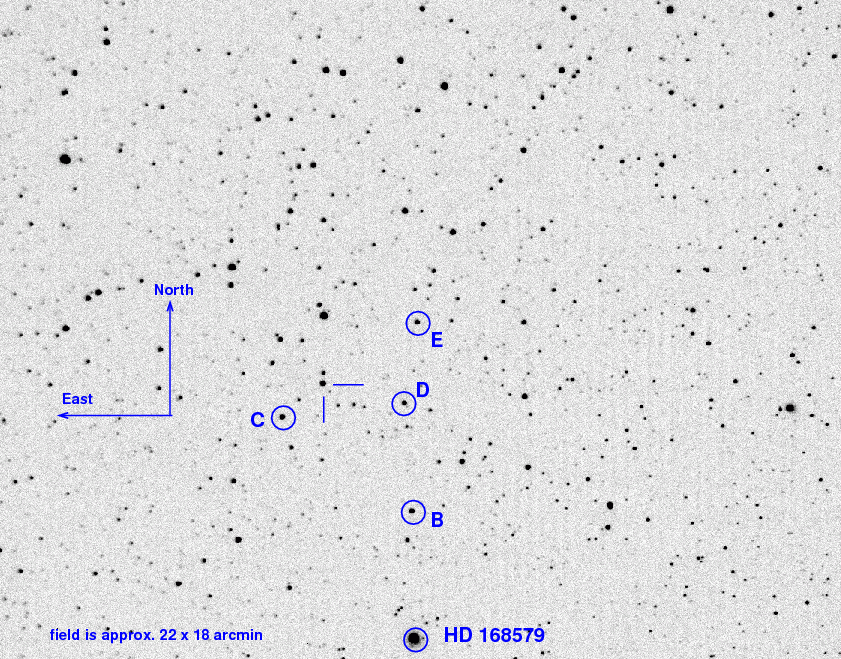
On the night of Mar 25/25, 2019, from about 3:20 AM until dawn, through clear skies, I acquired a set of observations of the likely black-hole system MAXIJ1820+070, (also known as ASASSN-18ey ).
These are the first measurements of this system I have made since Sep 24, 2018. Fortunately, the system started another outburst around Mar 12, 2019; see Astronomer's Telegram 12567. There were no major problems with the instruments, thanks to my colleague Jen Connelly and her capstone student Kain McCall. They started using the 12-inch telescope a few weeks ago, and exorcised all the demons which had crept in over the long and very cloudy winter.
The main setup was:
Notes from the night:
This optical and X-ray and radio transient is likely a black hole accreting material at a higher-than-usual rate. It has been the subject of many observers over the past year -- see the trail of telegrams that include
and re-started with its rebrightening in March 2019 with
The object is located at
RA = 18:20:21.9 Dec = +07:11:07.3
A chart of the field is shown below. The size of the chart is about 22 by 18 arcminutes.
I've marked the location of several comparison stars, which also appear in light curves below. Stars C, D, and E are mentioned by the Tomoe Gozen team in ATel 11426, but all three are rather red, with (B-V) ranging from 1.14 to 1.37. Star B is one of the bluest nearby bright stars, with (B-V) = 0.52.
star UCAC4 B V ---------------------------------------------------- B 486-079513 12.975 12.454 C 486-079608 13.968 12.830 D 486-079523 14.637 13.272 E 487-077858 14.637 13.272 ----------------------------------------------------
The dark current was pretty ordinary.

Since the temperatures were low, I operated the camera at T = -30 C instead of the usual -20 C. Note how similar the dark current was to the value measured at T = -30 C back on Nov 22, 2018. That's a good sign for the reproducibility of the camera.

The sky value shows no evidence for clouds; just a gradual drop as the target rose in the eastern sky.

Here's a record of the telescope's drift. I made no adjustments to the mount.
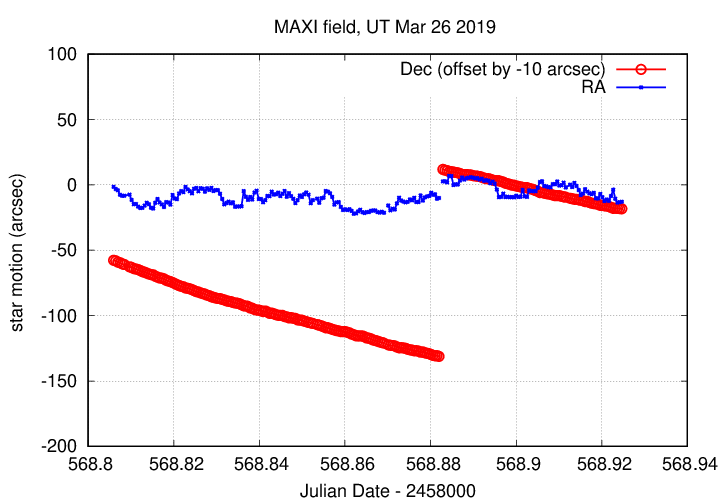
The number of objects detected -- I required 100 objects for an image to be included in the ensemble.
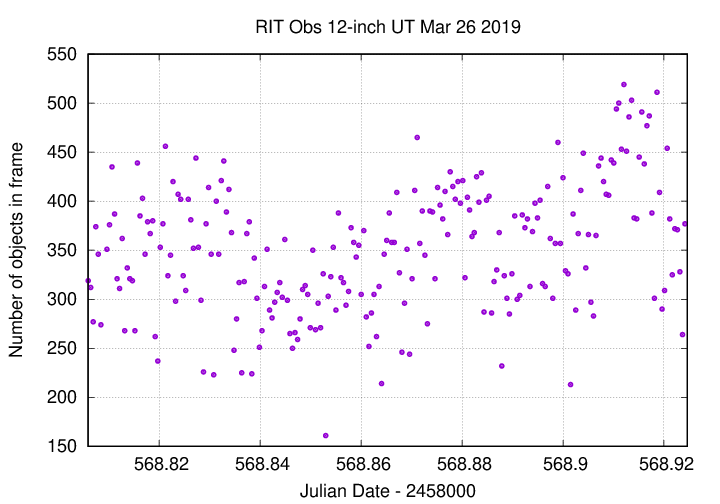
I used an aperture with radius 5.0 pixels. I made no changes to focus.

I discarded images which had obvious trailed stellar images, (3 of the 236 raw images).
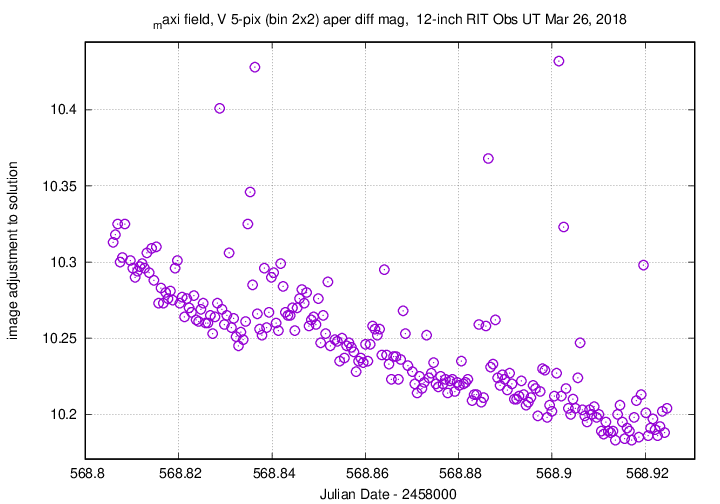
Using aperture photometry with a radius of 5 pixels (binned 2x2, each pixel is 1.34 arcsec, so a radius of 6.7 arcsec), I measured the instrumental magnitudes of a number of reference stars and the target. Following the procedures outlined by Kent Honeycutt's article on inhomogeneous ensemble photometry, I used all stars available in each image to define a reference frame, and measured each star against this frame.
Sigma-vs-mag plots show that the floor was about 0.008 mag overall; I marked the brightest star in the ensemble as "variable," due to saturation. The big outlier around instrumental magnitude 5.4 is MAXI J1820+070.
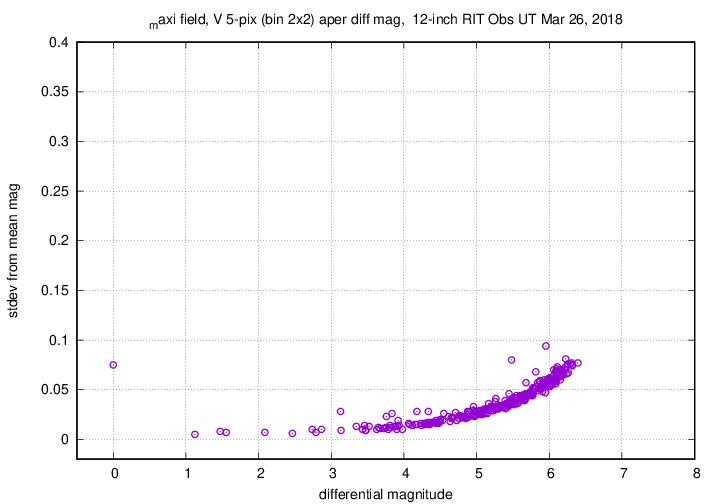
Here are light curves of the variable and the field stars.
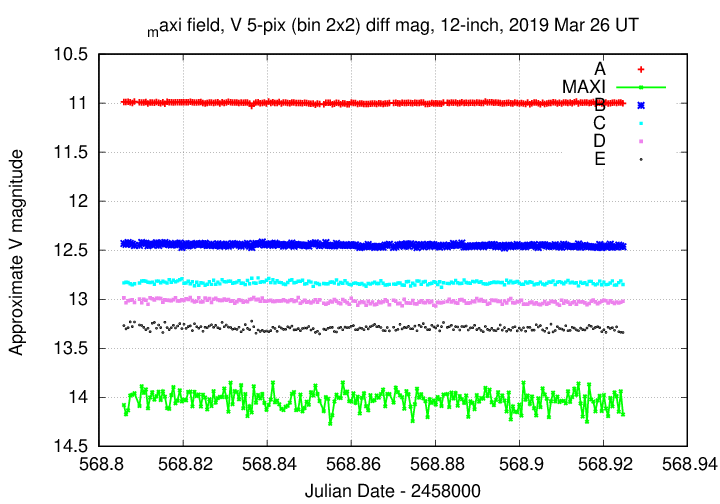
I used the UCAC value for the V-band magnitude of star "B" = UCAC4 486-079513 to shift the ensemble magnitudes to the standard V-band scale.
Here's a closeup on the variable. I'll connect the dots to make its behavior a bit easier to see. MAXI shows a scatter of about +/- 0.08 mag, clearly larger than that of stars of similar brightness. No obvious periodicity, and probably variations are faster than my 30-second images can reveal.
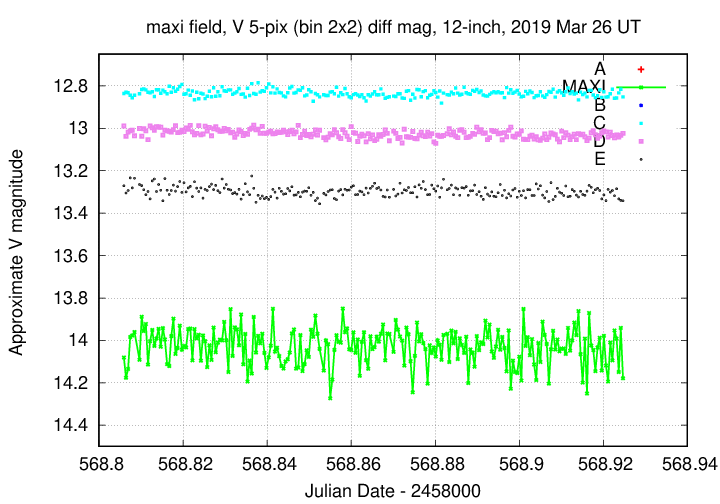
A very short section of the light curve shows the short-term variations more clearly.
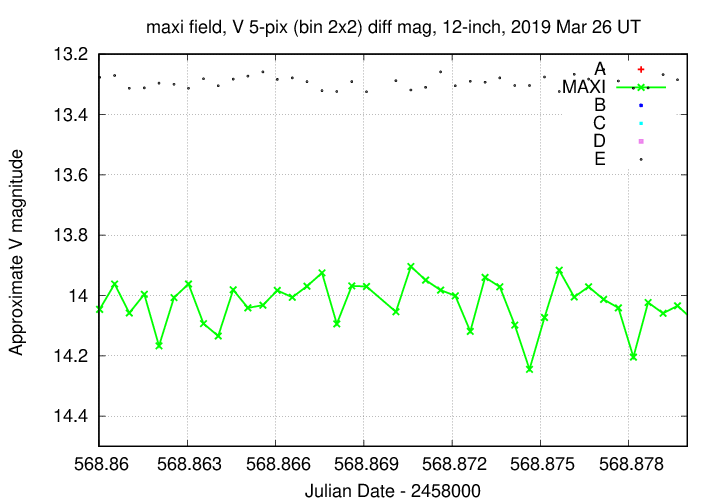
You can download my measurements below. A copy of the header of the file is shown to explain the format.
# Measurements of MAXIJ1820+070 made at RIT Obs, UT 2019 Mar 26, # in good conditions, # by Michael Richmond, # using Meade 12-inch LX200 and ATIK 11000. # Exposures 30 seconds long, V filter. # Tabulated times are midexposure (FITS header time - half exposure length) # and accurate only to +/- 1 second (??). # 'mag' is a differential magnitude based on ensemble photometry # using a circular aperture of radius 5 pix = 6.6 arcseconds. # which has been shifted so UCAC4 486-079513 has mag=12.454 # which is its V-band magnitude according to UCAC4. # # UT_day JD HJD mag uncert Mar26.30593 2458568.80593 2458568.80586 14.081 0.041 Mar26.30642 2458568.80642 2458568.80635 14.176 0.044 Mar26.30692 2458568.80692 2458568.80685 14.135 0.043
Last modified 3/26/2019 by MWR.